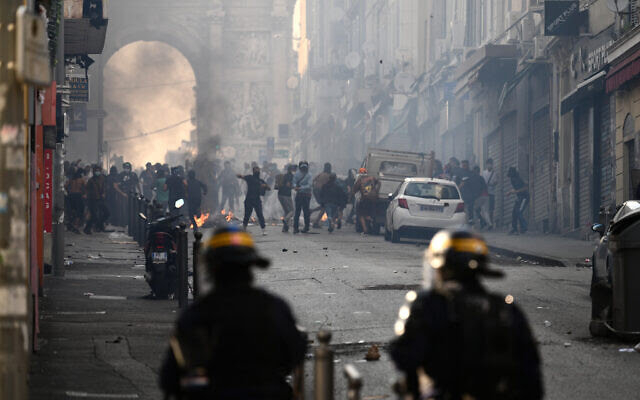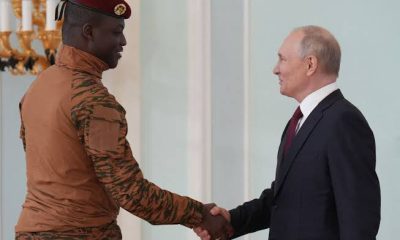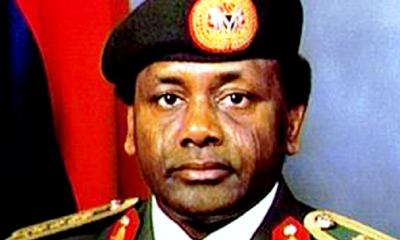
Foreign
France Protests: What You Need to Know About the Unrest
This article provides an overview of the causes, consequences, and challenges of the France protests that have rocked the country after a police killing.

France has been rocked by a wave of protests after a 17-year-old youth was shot by police near Paris on June 27, 2023, sparking a ban on demonstrations in some cities, travel warnings, and reigniting a debate on over-policing, racism, and social justice in France.
The unrest prompted a crisis response from French President Emmanuel Macron, who held an emergency meeting with ministers as he attempts to bridge divisions and unite the country in his second term.

This article provides an overview of the causes, consequences, and challenges of the protests.
RELATED: France Protests: Fires Rage As Police Detain Over 1,300 People on 4th Night
Causes of the France Protests
The incident that triggered the protests was the fatal shooting of Nahel, a 17-year-old boy of Algerian heritage, by a police officer during a traffic stop in Nanterre, a Paris suburb, on June 27, 2023.

Footage of the incident captured by a passerby showed that the officer fired his gun at Nahel despite not appearing to face any immediate threat.
The officer said he fired his gun because he was scared the boy would run someone over with the car, Nanterre prosecutor Pascal Prache said.
Prache said that it is believed that the officer acted illegally in using his weapon and that he is facing a formal investigation for voluntary homicide.
Nahel’s killing sparked outrage and grief among his family, friends, and community, who accused the police of racism and brutality. Nahel’s funeral on July 1, 2023, was attended by a large crowd of mourners who demanded justice and accountability for his death.
Nahel’s killing is also linked to a broader context of police violence and discrimination against ethnic minorities in France, especially those living in poor suburbs known as banlieues. Some of the previous cases of police killings or abuse that have sparked protests or riots in France are:
Adama Traoré in 2016, who died in police custody after being chased and pinned down by three officers in Beaumont-sur-Oise.
Zyed Benna and Bouna Traoré 2005, who were electrocuted in a power substation while hiding from police in Clichy-sous-Bois.
Malik Oussekine in 1986, was beaten to death by riot police during student protests in Paris.
Some of the statistics or reports that show the extent of racial profiling, excessive force or impunity among French police forces are:
– A 2017 report by Amnesty International found that France had failed to address systemic discrimination and human rights violations by police against ethnic minorities.
– A 2019 study by CNRS and ENS researchers found that young men perceived as black or Arab were 20 times more likely to be stopped and searched by the police than young men perceived as white.
– A 2020 report by Human Rights Watch documented dozens of cases of police violence against protesters, journalists, and bystanders during the yellow vests movement.
[the_ad id=”41670″]
Consequences of the France Protests
The protests have spread to other cities and have turned violent, with clashes between protesters and police, looting, arson, and vandalism. Some of the main events and developments that have occurred since the start of the protests on June 28, 2023, are:
Thousands of people have taken to the streets across France, mostly young men from marginalized backgrounds, chanting slogans such as “Justice for Nahel”, “No justice, no peace” or “ACAB” (All Cops Are Bastards).
Scenes of violence and destruction have taken place during the protests, such as burning cars and buses, looting shops, throwing projectiles at police, or setting fire to public buildings such as town halls, schools, or police stations.

Looting is taking place amid the riots, French authorities say. (Alexis Jumeau/SIPA/AP)
The authorities have taken measures to contain or suppress the protests, such as deploying riot police, using tear gas and water cannons, imposing curfews or bans on demonstrations in some cities such as Paris or Marseille, or arresting more than 1,300 people for various offenses.
The protests have had impacts or costs on public safety, social cohesion, economic activity, and international reputation. For example:
Several people have been injured or killed during the protests, including protesters, police officers, and bystanders.
The protests have exposed deep divisions and tensions within French society along racial, class, or political lines.
The protests have disrupted public transport, commerce, and tourism in several cities
The protests have damaged France’s image abroad as a stable and democratic country that respects human rights and the rule of law.
The protests have also drawn comparisons or contrasts with previous episodes of social unrest in France, such as the yellow vests movement in 2018-2019, which was triggered by rising fuel prices and living costs, or the suburban riots in 2005, which were sparked by the deaths of two teenagers chased by police.
Challenges of the France Protests
The protests pose challenges or difficulties for different actors or stakeholders involved in or affected by them. Some of the main challenges are:
For President Macron and his government, the challenge is to address or resolve the root causes of the protests, such as police reform, social justice or integration, while restoring order and security, and maintaining public support or legitimacy.

Protesters clash with riot police at the Porte d’Aix in Marseille, southern France on June 30, 2023, over the shooting of a teenage driver by French police in a Paris suburb on June 27. (Christophe Simon/AFP)
For the police, the challenge is to balance their duty to enforce the law and protect public safety with their respect for human rights and their accountability for their actions, while facing hostility or violence from some protesters or communities.
For the protesters, the challenge is to express their grievances and demands in a peaceful and constructive way, while avoiding violence, vandalism, or radicalization, and finding common ground or representation among themselves or with other actors.
For the media, the challenge is to report on the protests in an accurate and balanced way, while avoiding sensationalism, bias, or misinformation, and ensuring their safety and access to information.
For the public, the challenge is to understand and empathize with the different perspectives and experiences of those involved in or affected by the protests, while avoiding prejudice, polarization, or apathy.
Conclusion
Summarize the main points and findings of the article, which are that France has been rocked by a wave of protests after a 17-year-old boy was killed by police in Nanterre, that the protests have spread to other cities and have turned violent, that the protests have reignited a debate on over-policing, racism and social justice in France, and that the protests pose challenges for different actors or stakeholders.
Provide some recommendations or suggestions for possible solutions or actions that could help address or resolve the situation, such as dialogue, reform, education, or solidarity.
End with a call to action or a question that invites further discussion or reflection on the topic.
FAQs
Q. What are the main demands of the protesters?
A. The main demands of the protesters are justice and accountability for Nahel’s killing and other cases of police violence or abuse, reform of the police system and practices to end racial profiling, excessive force or impunity, and recognition and respect for the rights and dignity of ethnic minorities in France.
Q. How has President Macron responded to the protests?
A. President Macron has condemned the violence and called for calm and dialogue. He has also announced a series of measures to address some of the issues raised by the protesters, such as creating an independent watchdog to monitor police conduct, increasing diversity and training within police ranks, launching a national consultation on racism and discrimination, and investing more in education and employment opportunities for young people in disadvantaged areas.
Q. How do the protests compare to other social movements in France?
A. The protests share some similarities with other social movements in France, such as being triggered by a specific incident that reveals deeper grievances or inequalities, involving diverse groups of people from different backgrounds or regions, using social media or grassroots organizing to mobilize or communicate, and challenging the authority or legitimacy of the government or institutions. However, they also have some differences, such as being more focused on racial justice than economic justice, being more violent than peaceful



























